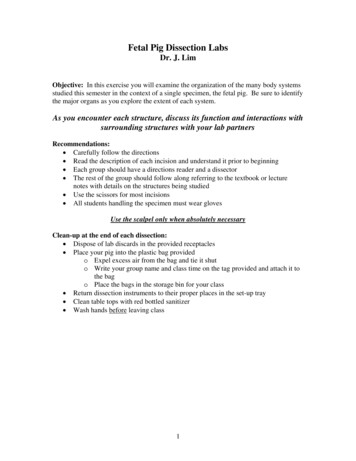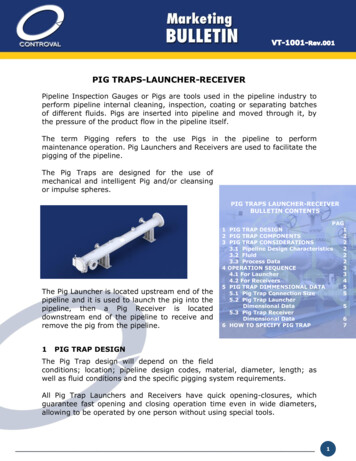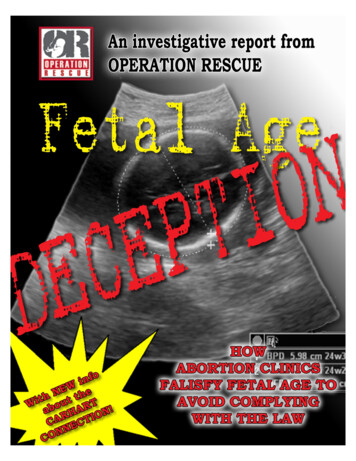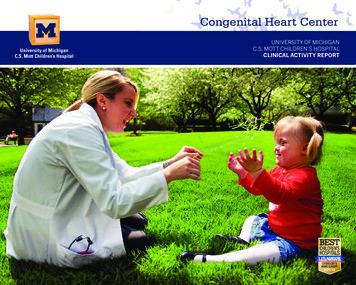
Transcription
Fetal Pig Dissection LabsDr. J. LimObjective: In this exercise you will examine the organization of the many body systemsstudied this semester in the context of a single specimen, the fetal pig. Be sure to identifythe major organs as you explore the extent of each system.As you encounter each structure, discuss its function and interactions withsurrounding structures with your lab partnersRecommendations: Carefully follow the directions Read the description of each incision and understand it prior to beginning Each group should have a directions reader and a dissector The rest of the group should follow along referring to the textbook or lecturenotes with details on the structures being studied Use the scissors for most incisions All students handling the specimen must wear glovesUse the scalpel only when absolutely necessaryClean-up at the end of each dissection: Dispose of lab discards in the provided receptacles Place your pig into the plastic bag providedo Expel excess air from the bag and tie it shuto Write your group name and class time on the tag provided and attach it tothe bago Place the bags in the storage bin for your class Return dissection instruments to their proper places in the set-up tray Clean table tops with red bottled sanitizer Wash hands before leaving class1
FETAL PIG LAB ONE: Respiratory 1, Mouth, Pharynx & ThoraxExternal Anatomy Examine the fetal pig and locate the external features shown above. Two rows of nipples of mammary glands are present on the ventral abdominalsurface of both males and females. Mammary glands later develop only inmaturing females. Umbilical cord: Make a transverse cut through the umbilical cord and examinethe cut end. Locate the two umbilical arteries that carry blood from the fetal pigto the placenta, and the single umbilical vein that delivers nutrient-rich blood backto the fetal pig. Determine the sex of your specimeno Female: The urogenital opening in the female is immediately ventral tothe anus and has a small genital papilla marking its location.o Male: The scrotal sac is ventral to the anus and a urogenital opening isjust posterior to the umbilical cord.Positioning the pig for dissectionPlace the fetal pig on a dissecting tray ventral (belly) side up. Use two or three rubberbands to tie the right hind leg around the ankle. Run the rubber bands around theunderside of the tray and tie the left hind leg. Repeat for the forelegs.2
Dissection ProcedureHEAD AND NECKTo expose the structures of the mouth and pharynx, start by inserting a pair of scissors inthe angle of the lips on one side of the head and cut posteriorly through the cheek. Openthe mouth as you make your cut and follow the curvature of the tongue to avoid cuttingthe roof of the mouth. Hold down the epiglottis and surrounding tissue and continueyour incision dorsal to it and on into the opening of the esophagus. Now, repeat theprocedure on the other side so that the lower jaw can be pulled down to expose thestructures of the mouth and pharynx as shown. Teeth: Only a fewdeciduous canineand/or incisor teethwill have erupted.Other teeth are stillbeing formed andmay present asbulges of the gums.Make an incision inone of these bulgesto observe thedeveloping tooth. Tongue: Thetongue is attachedposteriorly and freeanteriorly. Locatethe papillae on itssurface, especiallynear the base of thetongue and along itsanterior margins.You will recall that papillae are the home of many microscopic taste buds. Hard & Soft palate: roof of the moutho formed anteriorly by the hard palate supported by bone and cartilageo formed posteriorly by soft palateo paired nasal cavities lie dorsal to the roof of the mouth Nasopharnyx: space posteriorto the nasal cavities and softpalateo contiguous with theoropharynx or throat Oropharynx (throat): spaceposterior to the moutho Posterior extension ofnasopharynxo may be difficult to visualize because incision cuts through it on each side.3
When you have completed your observations, close the lower jaw by wrapping a singlerubber band around the snout.GENERAL INTERNAL ANATOMYUsing a sharp scalpel, make a small incision through the abdominal skin andmuscle about ½-inch above the umbilical cord. IMPORTANT: Do not use the scalpel forfurther dissection work today. Use scissors to continue cutting along the midsagittal lineon the ventral surface (INCISION 1), first cutting upward toward the neck (it will benecessary to cut through the ribs as well).Be careful not to cut any underlying organsAlways cut away from yourself when using scissors for better controlRotate the dissecting pan as necessary for better accessTurn the tray around and cut down tothe caudal (tail) end of the pelvic region,leaving ½- inch border around the umbilicalcord. This step is important to prevent cuttingof the umbilical vein and arteries in theabdominal cavity.Continue the midsagittal cut down intothe pelvic region. Cut around the other side ofthe umbilical cord (INCISION 2), againleaving about a ½-inch border. Stop your cutabout one inch short of the anus.Make the two lateral incisions just infront of the hind legs (INCISION 3).If you have a male pig, cutting off-centerensures that you do not cut the penis, which isincompletely formed in the fetal pig andappears as a thickened tube within the skin ofthe lower abdominopelvic area.You may omit INCISION 4.Make two lateral incisions (INCISION 5) through muscle and ribs out from themidline incision.Lifting the lateral flaps of ribs, skin and muscle on each side, cut the diaphragm,which is attached to the inside body wall. You should now be able to peel open the leftand right flaps of the ventral body wall like a book.Wash out the cavities of the pig in a sink if needed to remove any brownishmaterial (mainly bile and clotted blood) while being careful to keep the organs in place.You may loop the rubber bands around the legs as necessary to get a better viewinto your specimen. When you are finished with your pig, do not cut the rubber bands!Simply slide the rubber band from under the pan so that next time you need not retie thepig.4
THORACIC ORGANS Lungs: The thoracic cavity is divided into left and right pleural cavitiescontaining the lungs. At the midline, the inner thoracic wall forms a partitionbetween the pleural cavities called the mediastinum.Heart: The heart can be found enclosed in the pericardial sac located within themediastinum and attached to the diaphragm. Remove this sac to expose the heart.FETAL PIG LAB TWO: Respiratory 2, Neck & CardiovascularNECKIn the neck region, locate the larynx (voice box) which is composed of cartilage andcontains the vocal cords. The trachea (windpipe) extends posteriorly from the larynxand splits dorsal to the heart to form the bronchi that enter the lungs. These structuresare more clearly visible after the heart has been removed. Thymus gland: whitish gland that lies near the anterior margin of the heart andextends into the neck on each side of the trachea Thyroid gland: on anterior surface of the trachea at the base of the neckRemove the thymus and thyroid glands as necessary to get a better view of the tracheaand larynx, but do not cut major blood vessels Esophagus: carefully remove the connective tissue supporting the trachea so thatyou can move the trachea to one side to expose the esophagus located dorsal to ito you will get a better view of the esophagus later on5
CARDIOVASCULAR SYSTEMStudy the heart, major veins, and major arteries by carefully removing tissue asnecessary to expose the vessels. This is best done by separating tissues with a bluntprobe and by picking away connective tissue (CT) from the blood vessels with a forceps.In a fetus, the placenta is the source of oxygen and nutrients, and also removesmetabolic wastes from the blood. The lungs, digestive tract, and kidneys arenonfunctional. Circulatory adaptations to this condition make the circulation of blood inthe fetus quite different from your study of the adult cardiovascular system.Identify the following structures using the illustration as reference: Heart: carefully cut away the pericardial sac from heart and great vesselso locate atria, ventricles, coronary vessels Anterior vena cava: returns blood from head, neck, and forelegs to right atrium Posterior vena cava: returns blood from regions posterior to heart to rightatrium Pulmonary artery (trunk): carries blood from right ventricle Aorta: carries blood from left ventricle Umbilical vein: carries blood rich in oxygen and nutrients from placenta to fetus Ductus venosus: segment of umbilical vein going to liver and on to posteriorvena cava carrying blood rich in placental oxygen and nutrients6
Ductus arteriosus: carries blood from pulmonary trunk to aorta (bypassing thenon-functional lungs)o white and underneath apex of heart Umbilical arteries: carries waste-laden blood from pelvic region to placenta fordisposalAfter locating the major arteries and veins, carefully cut through the major vessels andremove the heart. Leave stubs of the vessels on the heart and identify them.RESPIRATORY SYSTEMReturn now to the neck and thoracic cavity to observe the respiratory organs. Locate thefollowing structures: Larynx: composed of cartilage and contains the vocal cords Trachea: note C-shaped cartilaginous rings Bronchi: trachea branches to form the two primary bronchio Note: these structures should be readily visible since the heart hasbeen removed dissect away connective tissue as needed Vocal cords: view on each side after making a mid-central incision in larynx Bronchioles: dissect along bronchus to view branching as it enters lungFETAL PIG LAB THREE: Digestive SystemDIGESTIVE SYSTEMDigestive organs in the abdomenIdentify the following structuresusing the illustration for reference. Liver: large, multilobedstructure under the lungsand diaphragm Gallbladder: lift up thelobes of the liver on theright side to find the small,green, saclike organ Esophagus: lies directlybehind the trachea; followits path from its beginningin the neck to its entry intothe stomach Stomach: saclike organunder the liver on the leftside Duodenum: first part ofthe small intestine attachedto the right side of thestomach7
Pancreas: begins in the loop between the stomach and duodenum and ends nearthe spleen on the left side; looks like a clump of about one hundred pinhead-sizedgrapesJejunum & Ileum: the coiled remainder of the small intestineCecum: the thumb like blind pouch at the junction of the ileum and colonColon (large intestine): usually darker, thicker, coiled (large) intestineRectum: the last one to two inches of large intestine leading to the anusFETAL PIG LAB FOUR: Urinary SystemRemove the intestines to expose the urinary organs. Leave a stub of the large intestine toallow for location of the rectum later.Dissect away surrounding tissue to expose the: Adrenal glands: on anterior surface of each kidney Kidneys: against dorsal body wallo Find the ureter, renal vein (thinner), and renal arteryo Make a frontal (longitudinal) section and observe the following kidney cortexkidney medullarenal pyramidsrenal columnscalycesrenal pelvisUreters: originate on medial surface ofkidney, near renal vessels Urinary bladder: follow both uretersposteriorly into the urinary bladder Urethra: urinary bladder narrowsposteriorly to form urethra entering pelvic cavity8
FETAL PIG LAB FIVE: Reproductive SystemExamine the reproductive system of your specimen. Exchange it for a specimen of theopposite sex from a classmate when you are finished.Male Reproductive System Testes: locate the testes within the scrotum (external pouch)Carefully cut open the scrotum to expose a testis. Epididymis: begins at anterior margin of testis extends to form vas deferens Vas deferens: extends anteriorly from scrotum and loops over ureter to enterurethra Urogenital opening: just posterior to umbilical cord in reflected flap of bodywall containing the urinary bladder Penis: extends posteriorly from urogenital openingMake an incision alongside the penis and free it from the body wall. Push it to oneside and use a scalpel to make a midline incision through the pelvic muscle andbones. Spread the legs and open the pelvic cavity so that you can dissect out thepelvic organs.9
Urethra: at the end of the urinary bladderRectum: located dorsal to the urethrao carefully remove the connective tissue around urethra to separate it fromthe rectumo continues posteriorly into pelvic cavitySeminal vesicles: small paired glands on each side of the urethraProstate gland: very small gland between seminal vesicles on dorsal surface ofurethraBulbourethral glands: paired glands on each side of urethra where it enters thepenisFemale Reproductive System Uterus & uterine tubes (horns): located dorsal to urinary bladder andventral to the descending colon (LI)Ovaries: follow uterine tubes anterolaterally to the ovarieso located just posterior to kidneys10
Remove or reflect the skin from the ventral surface of the pelvis. Use yourscalpel to cut carefully at the ventral midline through the muscles and bones of thepelvic girdle. Spread the legs and open the pelvic cavity to expose thecontinuation of the urethra and: Vagina: just dorsal to urethrao extends posteriorly from body of uterus Rectum: terminal portion of LIFINISHING UPTime permitting, feel free to revisit any part of this exercise.Actually seeing the structures you have been studying in the context of an entireorganism plus a free-flowing discussion of their anatomy and physiology should provevaluable in your preparation for upcoming examinations.Dispose of your specimen using the proper receptacles for organic matter and relatedmaterials respectively. Lastly, be sure to use the provided disinfectant to sanitize yourtabletops and to wash your hands with soap and water before leaving class.11
Carefully follow the directions . and the single umbilical vein that delivers nutrient-rich blood back to the fetal pig. Determine the sex of your specimen . You may loop the rubber bands around the legs as necessary










